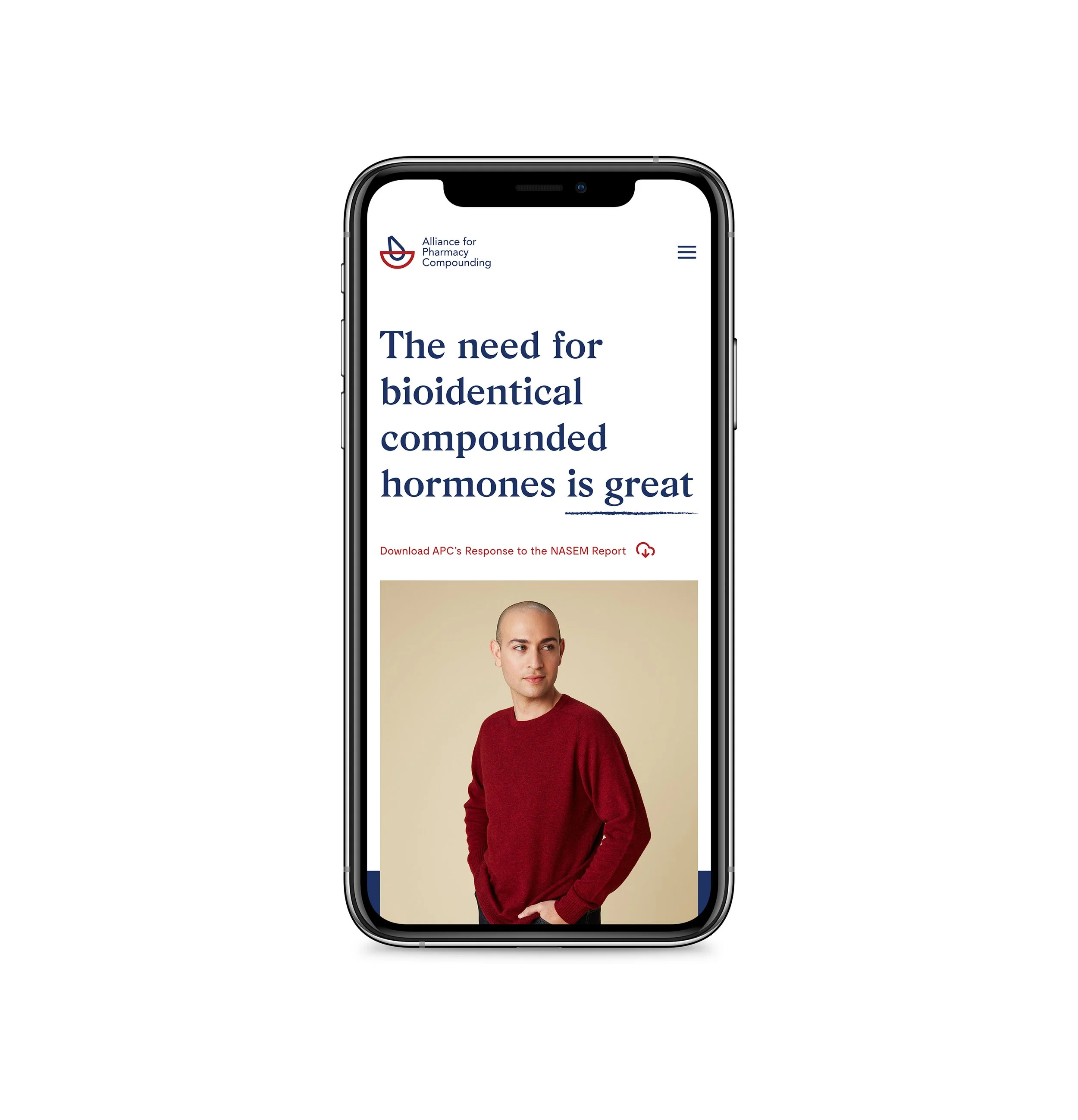Alliance for
Pharmacy Compounding
In 2021 the APC (Alliance for Pharmacy Compounding) launched an informative campaign in order to build awareness for the importance and need of compounded hormones for patients suffering from a wide variety of symptoms.
Company
Alliance for Pharmacy Compounding
Services
Website Design, User Experience
Photography
Project Facilitator
Project challenge/ Problem
A potential crisis for millions of americans
In 2020, the release of a report by the FDA sparked concerns about potential severe restrictions on compounded hormones, posing a significant health crisis for millions of people. The Alliance for Pharmacy Compounding (APC) recognized the urgency and took proactive measures to generate widespread social awareness. As part of this effort, I was responsible for establishing an informative and engaging web presence. The goal was to emphasize the importance of compounded pharmaceuticals, humanize the experiences of patients in need of such care, and provide users with a means to easily contact their respective congressmen to advocate for the preservation of proper treatment options.
Who should be targeted?
What conversions are necessary to measure success?
What is the voice/tone of this campaign?
How could we persuade users to reach out to their congressmen?
Why are compounded hormones so important?
REsearch / Highlights
Researching Target Audiences and Campaign Strategies for the APC Project
So what are compounded hormones exactly and why are they so important? Compounded hormones serve as customized treatments tailored to individual patient needs. These treatments can often be solutions to things such as dosing flexibility, allergen-free formulations, and hormone imbalances; all of which could prove to be detrimental to a patient’s health.
During the research phase for the APC project, a key focus was understanding the distinct paths required for each target audience. Outside of the website, audiences were engaged via digital ads, social media, print materials, etc; many of which directed people to the website. It was crucial to design the site in a way that effectively reached and engaged specific these audiences, with each user performing particular actions to drive the desired conversions. To gain insights into how to best approach the APC narrative, I examined a wide range of healthcare campaigns and studied editorial sites including The BBC and Forbes. The objective was to learn how major healthcare facilities targeted their users, whether it was for building awareness or driving conversions. Additionally, researching editorial sites provided valuable insights into how information should flow on the website, particularly when presenting specific reports and user-submitted stories.
There were several points that needed to be addressed:
Target Demographic: The campaign aimed to resonate with patients, physicians, pharmacists, and congressmen. It was crucial to create a seamless user experience that could effectively engage and convert each of these target groups.
Conversions: The targeted users were expected to perform three main tasks: sharing personal stories related to compounded hormones, reaching out to their congressmen, and encouraging legislative action.
Humanizing the Issue: While maintaining an informative approach, it was important to humanize the issue by putting a face to those in need. This approach would emphasize the real impact and significance of the matter.
Measurement of Success: Initial success would be measured by tracking user engagement with the site, specifically through video views and story submissions. The long-term goal involved influencing legislative change through the campaign, as users' concerns were communicated to congress via the APC.
Clear and accessible: The site needed to be accessible first and foremost and inform users of the importance of compounded hormones through excerpts and documentation. The site should also explain the benefits of Compounded Hormone Therapy (cBHT) for patients and medical professionals.
Personal Stories and Endorsements: By gaining support from patients and medical professionals via testimonials we could reinforce the importance of the campaign.
By considering these points, the design and implementation of the website could address the campaign's objectives and measure its impact.
Design And UX solutions
Empowering Voices: Humanizing the APC Message and Engaging Advocates
In order to humanize the issues advocated by the Alliance for Pharmacy Compounding (APC), utilizing real faces and personal stories became paramount to emphasize the significance of their message and build awareness. Although the website contained substantial information, it was crucial to encourage users, particularly pharmacists and patients, to share their own personal stories and feel a sense of community in their journey with Compounded Bioidentical Hormone Therapy (cBHT). User submissions were treated similar to sales testimonials, with segments of personal stories and calls-to-action (CTAs) strategically placed throughout the site to prompt new submissions.
After users submitted their stories or explored the provided documentation, the next crucial step was determining the course of action to be taken afterwards. They needed to engage with their respective state representatives. This was facilitated by a prompt following testimonial submission and the inclusion of a "Submit to Your Representative" feature in the header navigation. To simplify the process, the site integrated the Voter Voice tool, allowing users to input their information and either customize their message or use a pre-written one. While efforts were made to streamline the experience, an unavoidable challenge arose from the use of a third-party tool, necessitating users to provide their information twice. Ideally, the systems would have been merged for users who had previously submitted their stories, while still allowing direct navigation for users seeking their representative.
The successes of the APC website
Fully responsive design
Clear call to actions
WCAG compliant design choices
User testimonials serving as community engagement
Clear links to documentation and data to support the campaign.
Resulted in 11,000+ users interacting to reach out to Congress
ALL members of Congress were contacted
A total of 9,200 user stories were captured













